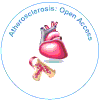Intracranial Atherosclerosis and Ischemic Stroke for Diagnosis, Symptoms and Treatment Approaches
Received Date: Jul 01, 2024 / Published Date: Jul 30, 2024
Abstract
Intracranial atherosclerosis is a major contributor to ischemic stroke, characterized by the accumulation of atherosclerotic plaques within the walls of intracranial arteries. The progression of this condition can lead to advanced intracranial stenosis, significantly increasing the risk of stroke. High-resolution magnetic resonance imaging (MRI) and intravascular ultrasound are pivotal in the diagnosis of intracranial atherosclerotic plaques, enabling precise detection and assessment of the disease. Symptoms of intracranial atherosclerosis-induced stroke typically include facial weakness, unilateral numbness of the arm or leg, and slurred speech. Management strategies focus on lowering cholesterol levels and controlling blood pressure through medication to mitigate stroke risk and improve patient outcomes. This review highlights the mechanisms, diagnostic methods, symptomatic presentation, and therapeutic approaches related to intracranial atherosclerosis and its role in ischemic stroke.
Citation: Michael K (2024) Intracranial Atherosclerosis and Ischemic Stroke for Diagnosis, Symptoms and Treatment Approaches. Atheroscler Open Access 9: 267. Doi: 10.4172/asoa.1000267
Copyright: © 2024 Michael K. This is an open-access article distributed under the terms of the Creative Commons Attribution License, which permits unrestricted use, distribution, and reproduction in any medium, provided the original author and source are credited.
Share This Article
Open Access Journals
Article Tools
Article Usage
- Total views: 499
- [From(publication date): 0-2024 - Mar 31, 2025]
- Breakdown by view type
- HTML page views: 323
- PDF downloads: 176
